

12 curation ideas for students AND teachers with Wakelet. Different Approaches To Using Student Blogs And Digital Portfolios. Ww2.kqed. Digital Portfolios Best Practices Infographic. Educational Technology Infographics Student Infographics Digital Portfolios Best Practices Infographic Digital Portfolios Best Practices Infographic Today’s students are the most accomplished and the most connected.
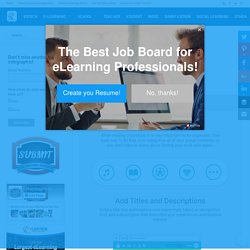
Back in the day, no one needed a resume until they were out of school. Now, even middle schoolers are being asked to submit completed resumes to apply for summer programs. A portfolio’s goal is to showcase your talents, skills, projects and recognitions. When you are building a portfolio, each item needs to have proper details. Set yourself up for success. Meet the modern learner [infographic] Profile of a 2020 learner - City & Guilds. Collaboration and Chaos: The Best Laid Plans Sometimes Fall Apart.
I am a big fan of the potential of collaborative projects.

I’ve instigated my fair share of activities in online spaces, inviting people to make with me, and I’ve participated in even more. There’s often a certain “magic” with writing and creating with other people with digital tools that demonstrates attributes that get at the heart of how technology is changing the ways we learn. Collaborative Learning Spaces: Classrooms That Connect to the World. Editor's note: This post is co-authored by Fran Siracusa, co-founder of and educational technologist for Calliope Global.
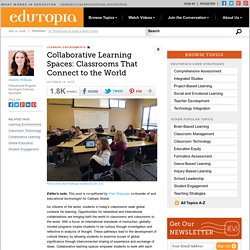
As citizens of the world, students in today's classrooms seek global contexts for learning. Every Student Should Have a Digital Portfolio Every student should have a collection of personal bests--a cloud-based story of their development and artifacts of accomplishment that's easily shareable in full or in part and organized for presentation.
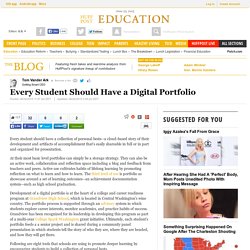
At their most basic level portfolios can simply be a storage strategy. They can also be an active work, collaboration and reflection space including a blog and feedback from teachers and peers. Active use cultivates habits of lifelong learning by promoting reflection on what to learn and how to learn. The third level of use is portfolio as showcase around a set of learning outcomes--an achievement documentation system--such as high school graduation. Development of a digital portfolio is at the heart of a college and career readiness program at Grandview High School, which is located in Central Washington's wine country. Learning with 'e's: #LearningIs connected. Moving Students From Digital Citizenship To Digital Leadership.
Moving Students From Digital Citizenship To Digital Leadership by TeachThought Staff Digital Citizenship has become one of the more symbolic phrases that represents the significant impact technology has made on our behavior and interactions.
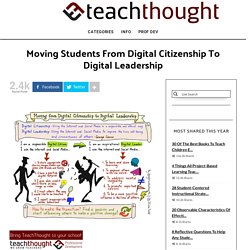
Digital Footprint: not everyone is equal and why unis need to teach managing DF as a 21st century skill. Australians are among the most digitally connected in the world and young people spend a lot of time online.
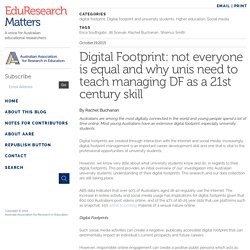
Most young Australians have an extensive digital footprint, especially university students. The Case for Cultivating Cultural Awareness. Sometimes students, parents, teachers, and administrators are comfortable living in the shells of their own existence.
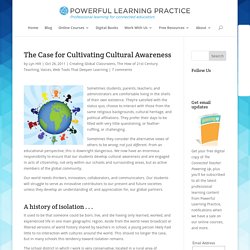
They’re satisfied with the status quo, choose to interact with those from the same religious backgrounds, cultural heritage, and political affiliations. They prefer their days to be filled with very little questioning, or feather-ruffling, or challenging. Sometimes they consider the alternative views of others to be wrong, not just different. From an educational perspective, this is downright dangerous. The Use of Social Media in School. Share this infographic on your site!

Embed this infographic on your site! The editors at Best Masters in Education decided to research the topic of: Teens are actively Tweeting, Posting, Liking, and Commenting all across Social Media and there doesn't seem to be an end in sight. Increasingly, teachers and schools are attempting to leverage the engaging qualities of Social Media for use in the classroom and beyond - connecting students, teachers, and parents better than ever before.
Social media as powerful method of learning – the evidence. Discussion around social media and learning tends to focus on the networking effects; the fact that you are in touch with others and gain from that nexus of expertise and knowledge.
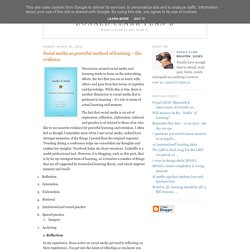
While this is true, there is another dimension to social media that is pertinent to learning – it’s role in terms of actual learning and memory. The fact that social media is an act of expression, reflection, elaboration, retrieval and practice is of interest to those of us who like to see concrete evidence for powerful learning and retention. I often feel as though I remember more when I use social media, indeed have stronger memories of the things I posted than the original exposure. Tweeting during a conference helps me consolidate my thoughts and capture key insights. 6 Ways for Teachers To Expand Their Personal Learning Network. If you’re an educator of any level, you know the importance of a great personal learning network.
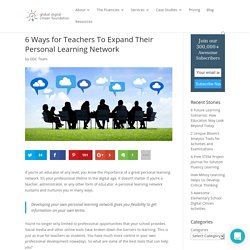
It’s your professional lifeline in the digital age. It doesn’t matter if you’re a teacher, administrator, or any other form of educator. A personal learning network sustains and nurtures you in many ways. Developing your own personal learning network gives you flexibility to get information on your own terms. You’re no longer only limited to professional opportunities that your school provides. The Essential Unique Search Tool Your Students May Have Never Used - November Learning. The Wayback Machine is as basic a reference tool for the Internet Age as a dictionary. When was the last time you saw a student use it? By Alan November. Empower digital citizenship action. Having multiple online identities is more normal than you think. Though my Instagram account is public, it isn't meant for my family to see.
I felt a little shy admitting this at the time, but I compartmentalize and curate my social media life to an exacting degree. For me, Instagram is for friends and people who know me through the internet. 7 Ways to Use Technology With Purpose. Why are you using technology? Or more importantly, how are you using technology to better the learning in your classroom and/or school? If you are like me, then you’ve had your fair share of technology screw ups. Projects that didn’t make sense (but used the tech you wanted to bring in). Activities that were ruined by a crashing website or some technological problem. Why Parents Shouldn't Feel Guilt About Their Kids' Screen Time. Texting isn't enough: Australian students' computer skills drop, new report shows. Ways to Implement Safe Social Media for Schools - Getting Smart by Guest Author - 21stedchat, edchat, EdTech, social media, treering. 10 Essential Questions for Teaching Global Digital Citizenship. Teaching Global Digital Citizenship is all about asking the right questions.
Best Way To Learn Any Subject: Curation — Content Curation Official Guide.